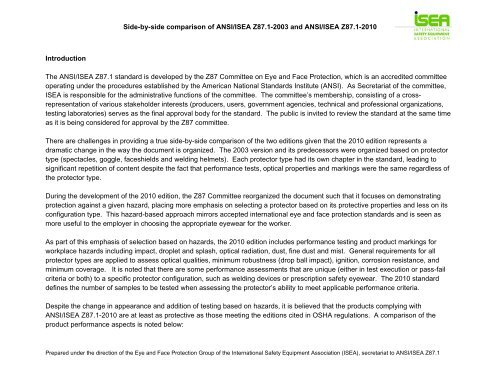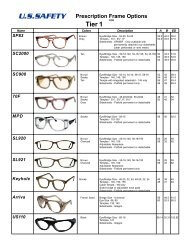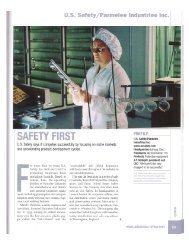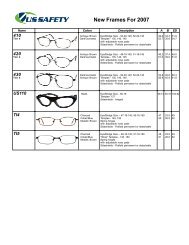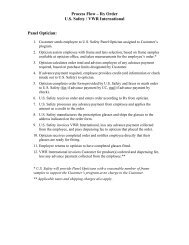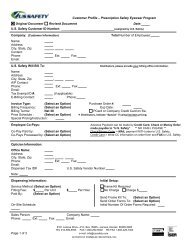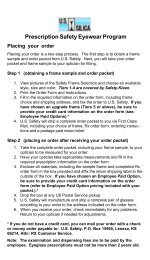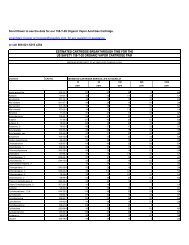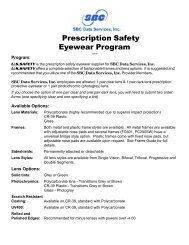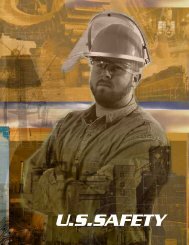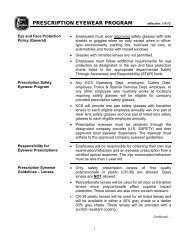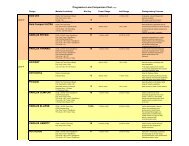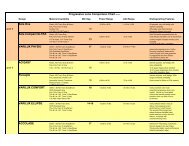Side-by-side comparison of ANSI/ISEA Z87.1-2003 and ... - US Safety
Side-by-side comparison of ANSI/ISEA Z87.1-2003 and ... - US Safety
Side-by-side comparison of ANSI/ISEA Z87.1-2003 and ... - US Safety
Create successful ePaper yourself
Turn your PDF publications into a flip-book with our unique Google optimized e-Paper software.
<strong>Side</strong>-<strong>by</strong>-<strong>side</strong> <strong>comparison</strong> <strong>of</strong> <strong>ANSI</strong>/<strong>ISEA</strong> <strong>Z87.1</strong>-<strong>2003</strong> <strong>and</strong> <strong>ANSI</strong>/<strong>ISEA</strong> <strong>Z87.1</strong>-2010<br />
Introduction<br />
The <strong>ANSI</strong>/<strong>ISEA</strong> <strong>Z87.1</strong> st<strong>and</strong>ard is developed <strong>by</strong> the Z87 Committee on Eye <strong>and</strong> Face Protection, which is an accredited committee<br />
operating under the procedures established <strong>by</strong> the American National St<strong>and</strong>ards Institute (<strong>ANSI</strong>). As Secretariat <strong>of</strong> the committee,<br />
<strong>ISEA</strong> is responsible for the administrative functions <strong>of</strong> the committee. The committee’s membership, consisting <strong>of</strong> a crossrepresentation<br />
<strong>of</strong> various stakeholder interests (producers, users, government agencies, technical <strong>and</strong> pr<strong>of</strong>essional organizations,<br />
testing laboratories) serves as the final approval body for the st<strong>and</strong>ard. The public is invited to review the st<strong>and</strong>ard at the same time<br />
as it is being con<strong>side</strong>red for approval <strong>by</strong> the Z87 committee.<br />
There are challenges in providing a true <strong>side</strong>-<strong>by</strong>-<strong>side</strong> <strong>comparison</strong> <strong>of</strong> the two editions given that the 2010 edition represents a<br />
dramatic change in the way the document is organized. The <strong>2003</strong> version <strong>and</strong> its predecessors were organized based on protector<br />
type (spectacles, goggle, faceshields <strong>and</strong> welding helmets). Each protector type had its own chapter in the st<strong>and</strong>ard, leading to<br />
significant repetition <strong>of</strong> content despite the fact that performance tests, optical properties <strong>and</strong> markings were the same regardless <strong>of</strong><br />
the protector type.<br />
During the development <strong>of</strong> the 2010 edition, the Z87 Committee reorganized the document such that it focuses on demonstrating<br />
protection against a given hazard, placing more emphasis on selecting a protector based on its protective properties <strong>and</strong> less on its<br />
configuration type. This hazard-based approach mirrors accepted international eye <strong>and</strong> face protection st<strong>and</strong>ards <strong>and</strong> is seen as<br />
more useful to the employer in choosing the appropriate eyewear for the worker.<br />
As part <strong>of</strong> this emphasis <strong>of</strong> selection based on hazards, the 2010 edition includes performance testing <strong>and</strong> product markings for<br />
workplace hazards including impact, droplet <strong>and</strong> splash, optical radiation, dust, fine dust <strong>and</strong> mist. General requirements for all<br />
protector types are applied to assess optical qualities, minimum robustness (drop ball impact), ignition, corrosion resistance, <strong>and</strong><br />
minimum coverage. It is noted that there are some performance assessments that are unique (either in test execution or pass-fail<br />
criteria or both) to a specific protector configuration, such as welding devices or prescription safety eyewear. The 2010 st<strong>and</strong>ard<br />
defines the number <strong>of</strong> samples to be tested when assessing the protector’s ability to meet applicable performance criteria.<br />
Despite the change in appearance <strong>and</strong> addition <strong>of</strong> testing based on hazards, it is believed that the products complying with<br />
<strong>ANSI</strong>/<strong>ISEA</strong> <strong>Z87.1</strong>-2010 are at least as protective as those meeting the editions cited in OSHA regulations. A <strong>comparison</strong> <strong>of</strong> the<br />
product performance aspects is noted below:<br />
Prepared under the direction <strong>of</strong> the Eye <strong>and</strong> Face Protection Group <strong>of</strong> the International <strong>Safety</strong> Equipment Association (<strong>ISEA</strong>), secretariat to <strong>ANSI</strong>/<strong>ISEA</strong> <strong>Z87.1</strong>
<strong>ANSI</strong>/<strong>ISEA</strong> <strong>Z87.1</strong>-<strong>2003</strong>/2010 Comparison – page 2<br />
General – Optical <strong>and</strong> Physical (for all protector types or individual configurations, as noted)<br />
OPTICAL REQUIREMENTS<br />
Criteria <strong>ANSI</strong>/<strong>ISEA</strong> <strong>Z87.1</strong>-<strong>2003</strong> <strong>ANSI</strong>/<strong>ISEA</strong> <strong>Z87.1</strong>-2010 Notes/Rationale<br />
Optical Quality<br />
Criteria for individual<br />
protectors. See:<br />
Section 7.4.3.1<br />
Section 7.5.3<br />
Section 8.4.1<br />
Section 9.4.1<br />
Section 10.5.1<br />
Section 5.1.1 (criteria)<br />
Section 9.1 (test method)<br />
No change.<br />
<strong>2003</strong> version included criteria<br />
<strong>and</strong> method in same section.<br />
2010 version separates them<br />
out for consistency in<br />
st<strong>and</strong>ard’s organization.<br />
Luminous Transmission<br />
(clear lenses)<br />
Criteria for individual<br />
protectors. See:<br />
Section 7.4.3.6<br />
Section 7.5.4<br />
Section 8.4.6<br />
Section 8.5.2<br />
Section 9.4.5<br />
Section 10.4.5<br />
Section 10.5.2<br />
Section 14.12 (test method)<br />
Table 1<br />
Section 5.1.2 (criteria)<br />
Section 9.2 (test method)<br />
No change.<br />
Haze<br />
Criteria for individual<br />
protectors. See:<br />
Section 7.4.3.5<br />
Section 8.4.5<br />
Section 9.4.4<br />
Section 14.11 (test method)<br />
Section 5.1.3 (criteria)<br />
Section 9.3 (test method)<br />
No change.
<strong>ANSI</strong>/<strong>ISEA</strong> <strong>Z87.1</strong>-<strong>2003</strong>/2010 Comparison – page 3<br />
Criteria <strong>ANSI</strong>/<strong>ISEA</strong> <strong>Z87.1</strong>-<strong>2003</strong> <strong>ANSI</strong>/<strong>ISEA</strong> <strong>Z87.1</strong>-2010 Notes/Rationale<br />
Refractive Power,<br />
Astigmatism – Plano<br />
Criteria for individual<br />
protectors. See:<br />
Section 7.4.3.3<br />
Section 8.4.3<br />
Section 10.4.2<br />
Section 14.10 (test method)<br />
Section 5.1.4 (criteria)<br />
Section 9.4 (test method)<br />
Table 1<br />
No change.<br />
All tolerances have been<br />
consolidated into a single<br />
table.<br />
Resolving Power – Plano<br />
Criteria for individual<br />
protectors. See:<br />
Section 7.4.3.4<br />
Section 8.4.4<br />
Section 9.4.3<br />
Section 10.4.3<br />
Section 14.10 (test method)<br />
Section 5.1.4 (criteria)<br />
Section 9.4 (test method)<br />
Table 1<br />
No change.<br />
.<br />
Prism <strong>and</strong> Prism Imbalance -<br />
Plano<br />
Criteria for individual<br />
protectors. See:<br />
Section 7.4.3.2<br />
Section 8.4.2<br />
Section 9.4.2<br />
Section 10.4.1<br />
Section 14.9 (test method)<br />
Section 5.1.4 (criteria)<br />
Section 9.4 (test method)<br />
Table 2<br />
No change.<br />
All tolerances have been<br />
consolidated into a single<br />
table.<br />
Refractive Power,<br />
Astigmatism, Prism <strong>and</strong> Prism<br />
Imbalance,– Prescription<br />
Section 7.5.3 Section 5.1.5 No change.<br />
Reference test method<br />
updated to reflect more<br />
current version.
<strong>ANSI</strong>/<strong>ISEA</strong> <strong>Z87.1</strong>-<strong>2003</strong>/2010 Comparison – page 4<br />
PHYSICAL REQUIREMENTS<br />
Criteria <strong>ANSI</strong>/<strong>ISEA</strong> <strong>Z87.1</strong>-<strong>2003</strong> <strong>ANSI</strong>/<strong>ISEA</strong> <strong>Z87.1</strong>-2010 Notes/Rationale<br />
Minimum Lens Thickness<br />
Criteria for individual<br />
protectors:<br />
Section 7.3.2<br />
Section 7.5.2.2<br />
Section 8.2.2.2<br />
Section 9.2.2.2<br />
Section 5.3, Table 3 (criteria)<br />
No change.<br />
Drop-Ball Impact Resistance<br />
Criteria for individual<br />
protectors. See:<br />
Section 7.3.1<br />
Section 7.4.1<br />
Section 7.5.1<br />
Section 8.2.2.1<br />
Section 9.2.2.1<br />
Section 10.2.2.1<br />
Section 14.4 (test method)<br />
Section 5.2.1 (criteria)<br />
Section 9.6 (test method)<br />
Applies part <strong>of</strong> the “basic<br />
impact” lens test from <strong>2003</strong><br />
version to a full assembly as<br />
an indicator <strong>of</strong> minimum<br />
overall robustness <strong>and</strong> is<br />
universally applied rather than<br />
being protector dependent.<br />
1 in. ball<br />
2.4 oz.<br />
50 in. drop<br />
Flammability<br />
Criteria for individual<br />
protectors. See:<br />
Section 7.6<br />
Section 8.6<br />
Section 9.6<br />
Section 10.6<br />
Section 14.6 (test method)<br />
Replaced with ignition test.<br />
(see below)<br />
Not representative <strong>of</strong> realistic<br />
use as it measured resistance<br />
to material igniting from<br />
contact with hot metal rather<br />
than the unlikely event that<br />
the device will be in flames.<br />
Ignition test (as noted below)<br />
replicate more realistic<br />
assessment for protectors.
<strong>ANSI</strong>/<strong>ISEA</strong> <strong>Z87.1</strong>-<strong>2003</strong>/2010 Comparison – page 5<br />
Criteria <strong>ANSI</strong>/<strong>ISEA</strong> <strong>Z87.1</strong>-<strong>2003</strong> <strong>ANSI</strong>/<strong>ISEA</strong> <strong>Z87.1</strong>-2010 Notes/Rationale<br />
Ignition None. Section 5.2.3 (criteria)<br />
Section 9.7 (test)<br />
New.<br />
Corrosion Resistance<br />
Criteria for individual<br />
protectors. See:<br />
Section 7.7<br />
Section 8.7<br />
Section 9.7<br />
Section 10.7<br />
Section 14.7 (test method)<br />
Section 5.2.4 (criteria)<br />
Section 9.8 (test method)<br />
No change.<br />
Cleanability<br />
Criteria for individual<br />
protectors. See:<br />
Section 7.8<br />
Section 8.8<br />
Section 9.8<br />
Section 10.8<br />
Section 14.7 (test method)<br />
Deleted.<br />
Assessment seen as too<br />
subjective to be useful.<br />
Manufacturers’ instructions<br />
tend to include cleaning<br />
instructions that will not<br />
compromise the device.<br />
Minimum Coverage None. Section 5.2.5 (criteria) Assures that little-to-none <strong>of</strong><br />
the s<strong>of</strong>t tissue within the<br />
wearer’s orbital socket is<br />
exposed to flying particles.
<strong>ANSI</strong>/<strong>ISEA</strong> <strong>Z87.1</strong>-<strong>2003</strong>/2010 Comparison – page 6<br />
OTHER REQUIREMENTS (configuration specific)<br />
Criteria <strong>ANSI</strong>/<strong>ISEA</strong> <strong>Z87.1</strong>-<strong>2003</strong> <strong>ANSI</strong>/<strong>ISEA</strong> <strong>Z87.1</strong>-2010 Notes/Rationale<br />
Ventilation, goggles Section 8.9<br />
Section 8.9.1<br />
Section 8.9.2<br />
Section 5.5.1<br />
Section 5.5.1.1<br />
Section 5.5.1.2<br />
Language specifies<br />
orientation <strong>of</strong> protector<br />
(maximum open position)<br />
when tested to other methods<br />
Screen windows <strong>and</strong> screen<br />
lenses<br />
Transmittance (non lens<br />
area), welding protectors<br />
Section 9.5 Section 5.5.2 No change.<br />
Criteria for individual<br />
protectors. See:<br />
Section 8.10<br />
Section 10.9.1<br />
Section 14.12 (test method)<br />
Section 5.5.3.1 (criteria)<br />
Section 9.2 (test method)<br />
Language clarifies area <strong>of</strong><br />
evaluation (that which<br />
exposes itself forward).<br />
Light Tightness, welding<br />
protectors<br />
Section 10.9.2 (criteria)<br />
Section 14.14 (test method)<br />
Section 5.5.3.2 (criteria)<br />
Section 9.9 (test method)<br />
No change.<br />
Frames for replaceable or<br />
removable lenses<br />
Section 5.5.4<br />
New. Language reflects<br />
movement toward completedevice<br />
testing as required <strong>by</strong><br />
the 2010 edition.<br />
Respiratory protection,<br />
Criteria for individual<br />
protectors. See:<br />
Section 11.2<br />
Section 11.3<br />
Section 11.4<br />
Section 11.5<br />
Section 5.5.5<br />
No change.
<strong>ANSI</strong>/<strong>ISEA</strong> <strong>Z87.1</strong>-<strong>2003</strong>/2010 Comparison – page 7<br />
Criteria <strong>ANSI</strong>/<strong>ISEA</strong> <strong>Z87.1</strong>-<strong>2003</strong> <strong>ANSI</strong>/<strong>ISEA</strong> <strong>Z87.1</strong>-2010 Notes/Rationale<br />
Replaceable Lenses, goggles<br />
<strong>and</strong> welding<br />
helmets/h<strong>and</strong>shields<br />
Criteria for individual<br />
protectors. See:<br />
Section 8.11<br />
Section 10.10<br />
Criteria for individual<br />
protectors. See:<br />
Section 5.6.1<br />
Section 5.6.2<br />
No change.<br />
Aftermarket Components Section 5.7 New.<br />
Requires that non-original<br />
equipment manufacturers <strong>of</strong><br />
devices that are represented<br />
as an “accessory” to<br />
protectors perform testing to<br />
assure that such accessory<br />
does not compromise the<br />
integrity <strong>of</strong> the Z87 protector.<br />
Also assures that replacement<br />
lenses, claimed as compatible<br />
with various frames, meet the<br />
st<strong>and</strong>ard in all combinations.<br />
These put structure <strong>and</strong><br />
requirements on the growing<br />
number <strong>of</strong> “universal”<br />
accessory <strong>and</strong> replacement<br />
parts being <strong>of</strong>fered.
<strong>ANSI</strong>/<strong>ISEA</strong> <strong>Z87.1</strong>-<strong>2003</strong>/2010 Comparison – page 8<br />
Assessments for Hazard-Based Protectors<br />
IMPACT RATED (referred to as high-impact in <strong>2003</strong> st<strong>and</strong>ard)<br />
Criteria <strong>ANSI</strong>/<strong>ISEA</strong> <strong>Z87.1</strong>-<strong>2003</strong> <strong>ANSI</strong>/<strong>ISEA</strong> <strong>Z87.1</strong>-2010 Notes/Rationale<br />
Frames <strong>and</strong> Shells Section 7.2 Section 6.1.2 2010 version requires that<br />
plano spectacles are to be<br />
tested as complete devices<br />
<strong>and</strong> allows prescription<br />
spectacles to be tested with a<br />
representative test lens<br />
Testing extended to frames<br />
<strong>and</strong> shells encompass testing<br />
<strong>of</strong> welding helmets.<br />
Lateral (<strong>side</strong> coverage) None. Section 6.1.3 (criteria)<br />
Section 9.10.1 (test method)<br />
2010 st<strong>and</strong>ard now requires<br />
lateral coverage for impact<br />
rated protectors. Inclusion is<br />
consistent with other<br />
international product<br />
st<strong>and</strong>ards.<br />
Assessment criteria <strong>and</strong> test<br />
method written to<br />
accommodate spectacles<br />
designed to be tested on the<br />
smaller headform.
<strong>ANSI</strong>/<strong>ISEA</strong> <strong>Z87.1</strong>-<strong>2003</strong>/2010 Comparison – page 9<br />
Criteria <strong>ANSI</strong>/<strong>ISEA</strong> <strong>Z87.1</strong>-<strong>2003</strong> <strong>ANSI</strong>/<strong>ISEA</strong> <strong>Z87.1</strong>-2010 Notes/Rationale<br />
High Mass<br />
High Velocity<br />
Criteria for individual<br />
protectors. See:<br />
Section 7.2.1<br />
Section 7.4.2.1.1<br />
Section 8.2.1.1<br />
Section 8.3.1.1<br />
Section 9.2.1.1<br />
Section 9.3.1.1<br />
Section 10.2.1.1<br />
Section 10.3.1.1<br />
Section 14.1 (test method)<br />
Criteria for individual<br />
protectors. See:<br />
Section 7.2.2<br />
Section 7.4.2.1.2<br />
Section 7.5.2.1<br />
Section 8.2.1.2<br />
Section 8.3.1.2<br />
Section 9.2.1.2<br />
Section 9.3.1.2<br />
Section 10.2.1.2<br />
Section 10.3.1.2<br />
Section 14.2 (test method)<br />
Section 6.2.2 (criteria)<br />
Section 9.11 (test method)<br />
Section 6.2.3 (criteria)<br />
Section 9.12 (test method)<br />
Table 5<br />
No change in pass/fail criteria.<br />
Test method language<br />
clarifies designated test height<br />
(50 in.) <strong>and</strong> changed the<br />
spherical radius <strong>of</strong> the missile<br />
from 1mm (<strong>2003</strong>) to<br />
3.175mm (2010) revision to<br />
provide a more “blunt” impact.<br />
Includes language to<br />
accommodate prescription<br />
lens carriers.<br />
No change in pass/fail criteria.<br />
Velocities have been<br />
consolidated into a single<br />
table.<br />
Assessment criteria <strong>and</strong> test<br />
method written to<br />
accommodate spectacles<br />
designed to be tested on the<br />
smaller headform.<br />
Testing includes fewer impact<br />
sites, in 30° increments <strong>and</strong><br />
defines the area <strong>of</strong> where the<br />
impact must occur at each<br />
test point.<br />
Includes language to<br />
accommodate prescription<br />
lens carriers.
<strong>ANSI</strong>/<strong>ISEA</strong> <strong>Z87.1</strong>-<strong>2003</strong>/2010 Comparison – page 10<br />
Criteria <strong>ANSI</strong>/<strong>ISEA</strong> <strong>Z87.1</strong>-<strong>2003</strong> <strong>ANSI</strong>/<strong>ISEA</strong> <strong>Z87.1</strong>-2010 Notes/Rationale<br />
Penetration<br />
Criteria for individual<br />
protectors. See:<br />
Section 7.3.3<br />
Section 7.4.2.1.3<br />
Section 8.2.2.3<br />
Section 8.3.1.3<br />
Section 9.2.2.3<br />
Section 9.3.1.3<br />
Section 10.2.2.2<br />
Section 10.3.1.3<br />
Section 14.2 (test method)<br />
Section 6.2.4 (criteria)<br />
Section 9.13 (test method)<br />
No change in pass/fail criteria.<br />
Assessed only for impactrated<br />
protectors.<br />
Test method section has been<br />
updated to specify that new<br />
needle must be used for each<br />
drop <strong>and</strong> specifies the<br />
diameter from the center <strong>of</strong><br />
the eye drop zone.
<strong>ANSI</strong>/<strong>ISEA</strong> <strong>Z87.1</strong>-<strong>2003</strong>/2010 Comparison – page 11<br />
OPTICAL RADIATION<br />
Criteria <strong>ANSI</strong>/<strong>ISEA</strong> <strong>Z87.1</strong>-<strong>2003</strong> <strong>ANSI</strong>/<strong>ISEA</strong> <strong>Z87.1</strong>-2010 Notes/Rationale<br />
Autodarkening Welding Filter<br />
(ADF) Lenses<br />
Section 10.12,1 <strong>and</strong> 10.12.2<br />
<strong>and</strong> 10.12.3 (criteria)<br />
Section 14.12 (test method)<br />
Table 1<br />
Section 7.1.3 (criteria)<br />
Section 9.2 (test method)<br />
Table 6<br />
Requires testing in lightest<br />
<strong>and</strong> darkest designated<br />
states, not each designated<br />
state.<br />
Table number references are<br />
changed, but spectral<br />
requirements for shades are<br />
unchanged.<br />
Switching Index (ADF)<br />
Section 10.12.4 (criteria)<br />
Section 14.13 (test method)<br />
Table 3<br />
Section 7.1.3.1 (criteria)<br />
Section 9.15 (test method)<br />
Table 11<br />
Clarifies that switching is<br />
measured from the light to<br />
dark state.<br />
Occlusion<br />
Section 10.12.5 (criteria)<br />
Section 14.10 (test method)<br />
Section 7.1.3.2 (criteria)<br />
Section 9.15 (test method)<br />
Table number references are<br />
changed, but switching<br />
speeds are unchanged.<br />
No change.<br />
Optical Radiation Filters<br />
---Special Purpose<br />
Lenses/Filters<br />
Specific descriptions:<br />
Section 6.1.1.6<br />
Section 6.1.2.3<br />
Section 6.1.3.2<br />
Section 6.1.4.1<br />
Section 10.11 (marking)<br />
Table 2<br />
Section 3 (definition)<br />
Table 10 (special purpose<br />
lenses transmittance)<br />
No change. “S” marking still<br />
applies.
<strong>ANSI</strong>/<strong>ISEA</strong> <strong>Z87.1</strong>-<strong>2003</strong>/2010 Comparison – page 12<br />
Criteria <strong>ANSI</strong>/<strong>ISEA</strong> <strong>Z87.1</strong>-<strong>2003</strong> <strong>ANSI</strong>/<strong>ISEA</strong> <strong>Z87.1</strong>-2010 Notes/Rationale<br />
Optical Radiation<br />
---Variable Tint Lenses<br />
Section 4 (definition)<br />
Section 6.2.4.5<br />
Section 3 (definition)<br />
No change. “V” marking still<br />
applies.<br />
Optical Radiation Filters<br />
---Clear <strong>and</strong> Filter<br />
Criteria for individual<br />
protectors with filter lenses:<br />
Section 7.4.3.6<br />
Section 7.5.4<br />
Section 8.4.6<br />
Section 8.5.2<br />
Section 9.4.5<br />
Section 10.4.5<br />
Section 10.5.2<br />
Section 14.12 (test method)<br />
Table 1<br />
Sections 7.1.1 <strong>and</strong> 7.1.2<br />
(criteria) except visible light<br />
filters<br />
Section 7.1.4 (criteria for light<br />
filters)<br />
Section 9.2 (test method)<br />
except visible light filters<br />
Spectral transmittance<br />
categories/requirements<br />
exp<strong>and</strong>ed to allow matching<br />
<strong>and</strong> selection <strong>of</strong> filters for<br />
radiation hazards in greater<br />
specificity than previous<br />
edition. Such is noted <strong>by</strong> the<br />
prefix markings for individual<br />
filters as noted below:<br />
Table 6 (welding filter<br />
transmittance)<br />
No change to spectral<br />
requirements. Added “W”<br />
prefix to shade markings to<br />
assist user in identifying<br />
specific filter that might be<br />
appropriate for hazard.
<strong>ANSI</strong>/<strong>ISEA</strong> <strong>Z87.1</strong>-<strong>2003</strong>/2010 Comparison – page 13<br />
Criteria <strong>ANSI</strong>/<strong>ISEA</strong> <strong>Z87.1</strong>-<strong>2003</strong> <strong>ANSI</strong>/<strong>ISEA</strong> <strong>Z87.1</strong>-2010 Notes/Rationale<br />
Table 7 (ultraviolet filter<br />
transmittance)<br />
Table 8 (infrared filter<br />
transmittance)<br />
Added ultraviolet filtration<br />
Scale numbers 2 through 6<br />
<strong>and</strong> added “U” prefix to<br />
indicate scale. This is to<br />
assist user in identifying<br />
specific filter that might be<br />
appropriate for hazard.<br />
Added infrared filtration Scale<br />
numbers 1.3 through 10 <strong>and</strong><br />
added “R” prefix to indicate<br />
scale. This is to assist user in<br />
identifying specific filter that<br />
might be appropriate for<br />
hazard.<br />
Section 7.1.4 (criteria)<br />
Table 9 (visible light filter<br />
transmittance)<br />
Incorporates reference to<br />
<strong>ANSI</strong> Z80.3-2008 st<strong>and</strong>ard to<br />
include requirements for color<br />
recognition that go with these<br />
filters.<br />
Added visible light filtration<br />
Scale numbers 1.3 through 10<br />
<strong>and</strong> added “L” prefix to<br />
indicate scale. This is to assist<br />
user in identifying specific<br />
filter that might be appropriate<br />
for hazard.
<strong>ANSI</strong>/<strong>ISEA</strong> <strong>Z87.1</strong>-<strong>2003</strong>/2010 Comparison – page 14<br />
Criteria <strong>ANSI</strong>/<strong>ISEA</strong> <strong>Z87.1</strong>-<strong>2003</strong> <strong>ANSI</strong>/<strong>ISEA</strong> <strong>Z87.1</strong>-2010 Notes/Rationale<br />
Transmittance categories for<br />
face shield windows<br />
Section 9.4.5 (criteria)<br />
Section 14.12 (test method)<br />
Designation <strong>of</strong> light, medium<br />
<strong>and</strong> dark faceshield no longer<br />
called out. The ranges for<br />
these previous designations<br />
are covered, in part, <strong>by</strong> Table<br />
9 for visible light filters. Such<br />
table was included in concert<br />
with the addition <strong>of</strong> tables for<br />
UV <strong>and</strong> IR lenses.<br />
Variations in Luminous<br />
Transmittance<br />
Note (3) to Table 1 Section 7.1.5 (criteria) No change.<br />
Transmittance <strong>of</strong> Housings –<br />
Goggles<br />
Transmittance <strong>of</strong> Housings –<br />
Faceshields<br />
Section 7.2.1 (criteria)<br />
Section 9.2 (test method)<br />
Section 7.2.2 (criteria)<br />
Section 9.2 (test method)<br />
New. Related to exp<strong>and</strong>ed<br />
optical radiation categories.<br />
New. Related to exp<strong>and</strong>ed<br />
optical radiation categories.
<strong>ANSI</strong>/<strong>ISEA</strong> <strong>Z87.1</strong>-<strong>2003</strong>/2010 Comparison – page 15<br />
DROPLET, SPLASH, D<strong>US</strong>T HAZARDS<br />
Criteria <strong>ANSI</strong>/<strong>ISEA</strong> <strong>Z87.1</strong>-<strong>2003</strong> <strong>ANSI</strong>/<strong>ISEA</strong> <strong>Z87.1</strong>-2010 Notes/Rationale<br />
Droplet <strong>and</strong> Splash Not included. Section 8.1 (criteria)<br />
Section 9.16 (test method)<br />
Dust Not included. Section 8.1 (criteria)<br />
Section 9.17 (test method)<br />
Fine Dust Not included. Section 8.1 (criteria)<br />
Section 9.18 (test method)<br />
Incorporation <strong>of</strong> test in<br />
consistent with other accepted<br />
international eye <strong>and</strong> face<br />
protection st<strong>and</strong>ards.<br />
Compliant products bear<br />
marking “D3” to assist users<br />
in identifying specific<br />
protectors that might be<br />
appropriate for hazard.<br />
Incorporation <strong>of</strong> test in<br />
consistent with other accepted<br />
international eye <strong>and</strong> face<br />
protection st<strong>and</strong>ards.<br />
Compliant products bear<br />
marking “D4” to assist users<br />
in identifying specific<br />
protectors that might be<br />
appropriate for hazard.<br />
Incorporation <strong>of</strong> test in<br />
consistent with other accepted<br />
international eye <strong>and</strong> face<br />
protection st<strong>and</strong>ards.<br />
Compliant products bear<br />
marking “D5” to assist users<br />
in identifying specific<br />
protectors that might be<br />
appropriate for hazard.


